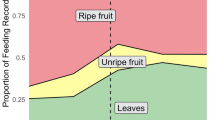Abstract
We examined factors affecting the size of chimpanzee parties in the Kalinzu Forest, Uganda. We found that the number of individuals in a party increased with observation time. Therefore, we employed two methods to reduce this bias: (1) we evaluated party size via the mean number of individuals observed in each 1-h period during the observation of a party (1-h party size), and (2) we used the number of all individuals observed in a party (1-day party size) and performed an analysis of covariance, with observation time of the party as the covariant. We examined factors that might affect party size: fruit abundance, fruit distribution, and number of estrous females. There was no relationship between party size and fruit abundance or distribution. Conversely, the number of males has a significant positive correlation with the number of estrous females, though there is no correlation with the number of anestrous females. These results suggest that males tended to join parties with more females in estrous, irrespective of differences in fruit availability.
Similar content being viewed by others
REFERENCES
Altman, J. (1974). Observational study of behavior sampling methods. Behaviour 49: 227-267.
Boesch, C. (1991). The effects of leopard predation on grouping patterns in forest chimpanzees. Behaviour 117: 220-242.
Boesch, C. (1996). Social grouping in Taï chimpanzees. In McGrew, W., Marchant, L., and Nishida, T. (eds.), Great Ape Societies, Cambridge University Press, Cambridge, pp. 101-113.
Chapman, C. A., White, F. J., and Wrangham, R. W. (1994a). Party size in chimpanzees and bonobos. In Wrangham, R. W., McGrew, W. C., deWaal, F. B. M., and Heltne, P. G. (eds.), Chimpanzee Cultures, Harvard University Press, Cambridge, pp. 41-57.
Chapman, C. A., Wrangham, R., and Chapman, L. J. (1994b). Indices of habitat-wide fruit abundance in tropical forests. Biotropica 26: 160-171.
Chapman, C. A., Wrangham, R. W., and Chapman, L. J. (1995). Ecological constraints of group size: An analysis of spider monkey and chimpanzee subgroups. Behav. Ecol. Sociobiol. 36: 59-70.
Doran, D. (1997). Influence of seasonality on activity patterns, feeding behavior, ranging, and grouping patterns in Taï chimpanzees. Int. J. Primatol. 18: 183-206.
Furuichi, T., Hashimoto, C., and Tashiro, Y. (2001). Extended application of a marked-nest census method to examine seasonal changes in habitat use by chimpanzees. Int. J. Primatol. 22: 913-928.
Goodall, J. (1986). The Chimpanzees of Gombe/Patterns of Behavior, Harvard University Press, Cambridge.
Hashimoto, C. (1995). Population census of the chimpanzees in the Kalinzu Forest, Uganda: Comparison between methods with nest counts. Primates 36: 477-488.
Hashimoto, C. (1999). Observations on the injuries sustained by wild chimpanzees in the Kalinzu Forest, Uganda. Primate Res. 15: 187-192 (in Japanese with an English abstract).
Hashimoto, C., Furuichi, T., and Tashiro, Y. (2000). Ant dipping and meat eating by wild chimpanzees in the Kalinzu Forest, Uganda. Primates 41: 103-108.
Hashimoto, C., Furuichi, T., Tashiro, Y., and Kimura, D. (1999). Vegetation of the Kalinzu Forest, Uganda: Ordination of forest types using principal component analysis. Afr. Study Monogr. 20: 229-239.
Howard, P. C. (1991). Nature Conservation in Uganda's Tropical Forest Reserves, IUCN, Gland, Switzerland and Cambridge.
Matsumoto-Oda, A. (1999). Mahale chimpanzees: Grouping patterns and cycling females. Am. J. Primatol. 47: 197-207.
Matsumoto-Oda, A., Hosaka, K., Huffman, M. A., and Kawanaka, K. (1998). Factors affecting party size in chimpanzees of the Mahale Mountains. Int. J. Primatol. 19: 999-1011.
Riss, D. C., and Busse, C. (1977). Fifty day observation of a free-ranging adult male chimpanzee. Folia Primatol. 28: 283-297.
Sakura, O. (1994). Factors affecting party size and composition of chimpanzees (Pan troglodytes verus) at Bossou, Guinea. Int. J. Primatol. 15: 167-183.
Sokal, R. R. and Rohlf, F. J. (1995). Biometry: The principles and Practice of Statistics in Biological Research, 3rd Edition. Freeman, New York.
Stanford, C. B., Wallis, J., Mpongo, E., and Goodall, J. (1994). Hunting decisions in wild chimpanzees. Behaviour 131: 1-18.
Tutin, C. E. G., McGrew, W. C., and Baldwin, P. J. (1983). Social organization of savanna-dwelling chimpanzees, Pan troglodytes verus, at Mt. Assirik, Senegal. Primates 24: 154-173.
Tutin, C. E. G., Rebecca, M. H., White, L. J. T., and Harrison, M. J. S. (1997). The primate community of the Lope Reserve, Gabon: Diets, responses to fruit scarcity, and effects on biomass. Am. J. Primatol. 42: 1-24.
Wrangham, R. W. (1977). Feeding behaviour of chimpanzees in Gombe National Park, Tanzania. In Clutton-Brock, T. H. (ed.), Primate Ecology: Studies of Feeding and Ranging Behaviour in Lemurs, Monkeys and Apes, Academic Press, London, New York, and San Francisco, pp. 503-538.
Wrangham, R. W. (2000). Why are male chimpanzees more gregarious than mothers? A scramble competition hypothesis. In Kappeler P. M. (ed.), Primate Males: Causes and Consequences of Variation in Group Composition, Cambridge University Press, Cambridge, pp. 248-258.
Wrangham, R.W., Chapman, C. A., Clark-Arcadi, A. P., and Isabirye-Basuta, G. (1996). Social ecology of Kanyawara chimpanzees: Implications for understanding the costs of great ape groups. In McGrew, E. W., Marchant, L. F., Nishida, T. (eds.), Great Ape Societies, Cambridge University Press, pp. 45-57.
Wrangham, R. W., Clark, A. P., and Isabirye-Basuta, G. (1992). Female social relationships and social organization of Kibale Forest chimpanzees. In Nishida, T., McGrew, W. C., Marler, P., Pickford, M., and deWaal, F. B. M. (eds.), Topics in Primatology Vol. 1 Human Origins, University of Tokyo Press, Tokyo, pp. 81-98.
Wrangham, R. W., Conklin, N. L., Etot, G., Obua, J., Hunt, K. D., Hauser, M. D., and Clark, A. P. (1993). The value of figs to chimpanzees. Int. J. Primatol. 14: 243-256.
Yamakoshi, G. (1998). Dietary responses to fruit scarcity of wild chimpanzees at Bossou, Guinea: Possible implications for ecological importance of tool use. Am. J. Phys. Anthropol. 106: 283-295.
Author information
Authors and Affiliations
Corresponding author
Rights and permissions
About this article
Cite this article
Hashimoto, C., Furuichi, T. & Tashiro, Y. What Factors Affect the Size of Chimpanzee Parties in the Kalinzu Forest, Uganda? Examination of Fruit Abundance and Number of Estrous Females. International Journal of Primatology 22, 947–959 (2001). https://doi.org/10.1023/A:1012061504420
Issue Date:
DOI: https://doi.org/10.1023/A:1012061504420




